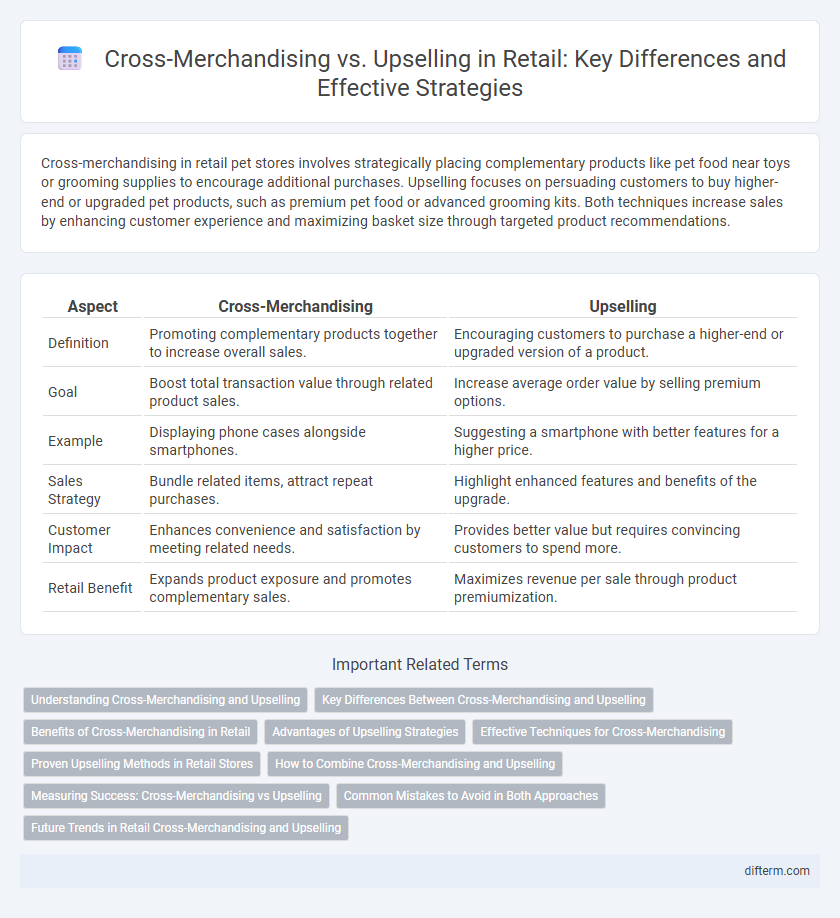Cross-merchandising in retail pet stores involves strategically placing complementary products like pet food near toys or grooming supplies to encourage additional purchases. Upselling focuses on persuading customers to buy higher-end or upgraded pet products, such as premium pet food or advanced grooming kits. Both techniques increase sales by enhancing customer experience and maximizing basket size through targeted product recommendations.
Table of Comparison
| Aspect | Cross-Merchandising | Upselling |
|---|---|---|
| Definition | Promoting complementary products together to increase overall sales. | Encouraging customers to purchase a higher-end or upgraded version of a product. |
| Goal | Boost total transaction value through related product sales. | Increase average order value by selling premium options. |
| Example | Displaying phone cases alongside smartphones. | Suggesting a smartphone with better features for a higher price. |
| Sales Strategy | Bundle related items, attract repeat purchases. | Highlight enhanced features and benefits of the upgrade. |
| Customer Impact | Enhances convenience and satisfaction by meeting related needs. | Provides better value but requires convincing customers to spend more. |
| Retail Benefit | Expands product exposure and promotes complementary sales. | Maximizes revenue per sale through product premiumization. |
Understanding Cross-Merchandising and Upselling
Cross-merchandising involves strategically displaying complementary products together to encourage additional purchases, enhancing the overall shopping experience and increasing average transaction value. Upselling focuses on persuading customers to purchase a higher-end product or add features, maximizing revenue per sale through value-driven suggestions. Both techniques leverage consumer behavior insights to boost sales, but cross-merchandising emphasizes product pairing while upselling prioritizes upgrading the purchase.
Key Differences Between Cross-Merchandising and Upselling
Cross-merchandising enhances customer experience by strategically placing complementary products together, such as pairing coffee with pastry items, to encourage multiple item purchases. Upselling focuses on increasing the value of a single transaction by persuading customers to buy a more expensive or upgraded version of a product, like recommending a premium smartphone model. The key difference lies in cross-merchandising targeting product combinations to boost overall sales volume, while upselling aims to maximize revenue per sale through higher-priced options.
Benefits of Cross-Merchandising in Retail
Cross-merchandising enhances retail sales by strategically placing complementary products together, boosting average transaction values and improving customer convenience. This approach increases product visibility and encourages impulse purchases, leading to higher conversion rates and inventory turnover. Retailers benefit from optimized store layout and personalized shopping experiences that strengthen brand loyalty and drive sustained revenue growth.
Advantages of Upselling Strategies
Upselling strategies in retail significantly increase average transaction value by encouraging customers to purchase higher-end products or additional features. These techniques enhance customer experience through personalized recommendations that align with their needs and preferences, fostering loyalty and repeat business. Implementing upselling also improves profit margins by promoting premium items and exclusive offers, driving revenue growth efficiently.
Effective Techniques for Cross-Merchandising
Cross-merchandising enhances retail sales by strategically placing complementary products together, such as pairing coffee makers with coffee pods, which encourages customers to purchase multiple related items. Effective techniques include creating themed displays, utilizing end caps to highlight cross-sell combinations, and employing data analytics to identify frequently bought-together products. This approach not only increases average transaction value but also improves customer shopping experience by offering convenient product pairings.
Proven Upselling Methods in Retail Stores
Proven upselling methods in retail stores include personalized product recommendations, bundling complementary items, and training sales associates to highlight premium features that align with customer needs. Leveraging data analytics to identify purchase patterns enables retailers to tailor upsell offers effectively, increasing average transaction value. In contrast to cross-merchandising, which strategically places related products together to boost sales, upselling directly encourages customers to upgrade or add higher-value items during the buying process.
How to Combine Cross-Merchandising and Upselling
Combining cross-merchandising and upselling in retail enhances customer experience by strategically placing complementary products together while offering premium or higher-value alternatives to increase average transaction value. Effective implementation involves using data-driven insights to personalize product recommendations, such as pairing accessories with electronics and suggesting upgraded versions or bundles at checkout. Leveraging both techniques simultaneously maximizes sales opportunities and improves customer satisfaction by meeting diverse shopping needs in a single interaction.
Measuring Success: Cross-Merchandising vs Upselling
Measuring success in retail involves tracking key performance indicators such as average transaction value, conversion rates, and customer engagement for both cross-merchandising and upselling strategies. Cross-merchandising effectiveness is often reflected in increased basket size and complementary product sales, while upselling success is indicated by higher revenue per transaction and improved profit margins. Retailers use tools like sales analytics, customer feedback, and CRM data to evaluate which approach drives greater overall profitability and customer satisfaction.
Common Mistakes to Avoid in Both Approaches
Cross-merchandising often suffers from inconsistent product pairing that confuses customers and reduces overall sales potential, while upselling mistakes typically include pushing irrelevant or overly expensive items, which can lead to customer dissatisfaction. Retailers should avoid neglecting customer data and preferences, as failing to align offers with shopper behavior diminishes the effectiveness of both strategies. Overloading displays and creating cluttered stores disrupts the shopping experience and undermines the benefits of strategic product placement and personalized recommendations.
Future Trends in Retail Cross-Merchandising and Upselling
Future trends in retail cross-merchandising emphasize AI-driven personalized product pairings that enhance customer experience and increase average transaction value. Upselling strategies are evolving with machine learning algorithms that predict customer preferences in real time, offering tailored premium options. Integration of augmented reality (AR) technology allows interactive cross-merchandising displays, boosting engagement and conversion rates.
Cross-merchandising vs Upselling Infographic

 difterm.com
difterm.com